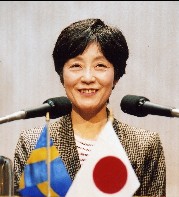��Science Interpreter as a Bridge over Chasms between Society and Science��
February 8th, 2006
Ms. Reiko Kuroda,
Professor of the Graduate School of Arts and Sciences, University of Tokyo
Member of the Council for Science and Technology Policy, Cabinet Office
 The basic plans have been formulated for the third term (2006 to 2010) of the science and technology creation planning. They present the following five major points, with the main focus on enhancing the global competitiveness of Japan, a nation built on the platform of scientific and technological creativity, as its way for survival.
The basic plans have been formulated for the third term (2006 to 2010) of the science and technology creation planning. They present the following five major points, with the main focus on enhancing the global competitiveness of Japan, a nation built on the platform of scientific and technological creativity, as its way for survival.
1. Science and technology supported by society and people, returning outcomes to them
2. Thorough selection and concentration of materials
3. Shifting from materials to people, with emphasis on individuals in organizations, as well as development and upgrading of human resources in science and technology
4. Structural reforms to achieve the world��s highest level of science and technology, and enduring implementation of scientific and technological innovations
5. Reinforced control functions of the Council for Science and Technology Policy
It is beyond discussion that human resources are assets. Competent human resources become leaders in charge of research and development projects of science and technology.
At its meeting held in Budapest in 1999, the World Conference on Science adopted the ��Declaration on Science and the Use of Scientific Knowledge��, proclaiming that science should be in society and for society, while science for knowledge and for progress was sought theretofore.
Science and technology have developed rapidly. Your counterparts in the personal computer telecommunication may be foreigners with different cultural and traditional backgrounds, but it is impossible for you to identify such difference on computer screens.
Physicists and biologists may not interface with each other, because there are so many things that have become a black box. Even between physicists, interfaces with each other are sometimes impossible if their specialized fields are different. For this reason, interpreters are also necessary for the interface between scientists.
The term of ��Science Interpreter�� was used for the first time in my article of ��Proposals for the 21st Century��, which was released in the Asahi Shimbun in June 1996. Its key word is bi-directionality.
Science interpreters are human resources to mediate communication not only between an expert on science and technology and a person unfamiliar with science and technology, but also between scientists with different specialties.
Scientists should indicate what effects of their studies have on society and what meanings their researches have in society. Otherwise, they just write theses intended only for scholarly groups, and they tend to commit themselves to finding new knowledge.
In these circumstances, I strongly appeal for the nurturing of human resources who can encourage scientists to speculate social meanings of their studies, and to fulfill their responsibility for explaining their researches, and for active roles of such human resources with bi-directionality.
It is required that science interpreters will develop an ability to think by themselves, and that they will acquire and sharpen an ability to read and comprehend backdrops of information and data. They need scientific knowledge and thinking which serve as any basis for making decisions.
I believe that science will not decide which is right or wrong. Science will even widen gray areas. Average discussions require considerations for distributions. It is important to remember that materials have physical and chemical behaviors as well as social characters.
Tokyo University��s training program of science and technology interpreters targets an education of a few elites (about ten), selected from university-wide graduate students in arts and sciences. The selection criteria are as follows:
1. Students who can be impressed by grandeur, splendor, and wonder of nature
2. Students who have strong basic knowledge of science
3. Students who can understand the essence of science and enter into scientific thinking, when they experience scientific phenomena
4. Students who have an awareness of science in society
5. Students who are sympathetic to people��s minds
6. Students who have richly expressive power
7. Students who have adequate English ability, etc.
We are committed to the nurture and education of selected students with these qualifications, expecting that they will become good science interpreters.